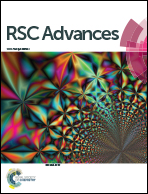Sorptive removal of Remazol Brilliant Blue R from aqueous solution by diethylenetriamine functionalized magnetic macro-reticular hybrid material†
Abstract
Chitosan (natural polymer), glycidyl methacrylate (synthetic polymer) and magnetite are combined to produce novel magnetic macro-reticular hybrid synthetic–natural materials. The amino group concentration in the obtained materials was enriched through two different modification routes to generate effective sorbents for Remazol Brilliant Blue R (RBBR) ions. These materials showed a higher affinity towards the uptake of RBBR ions from aqueous media: maximum sorption capacity reached 0.153 mmol g−1 at pH 2.0 and at 25 °C. The nature of the interaction of RBBR with the sorbents was identified. The uptake kinetics and sorption isotherms were best described by the pseudo-second order rate equation and the Langmuir equation, respectively. The distribution coefficient was calculated at different temperatures and the thermodynamic parameters have been calculated: the sorption reaction is endothermic, spontaneous and increases the entropy of the system. Alkaline solution (0.5 M NaOH) was used for desorbing RBBR from loaded sorbents: a regeneration efficiency as high as 90–99% was obtained.



 Please wait while we load your content...
Please wait while we load your content...